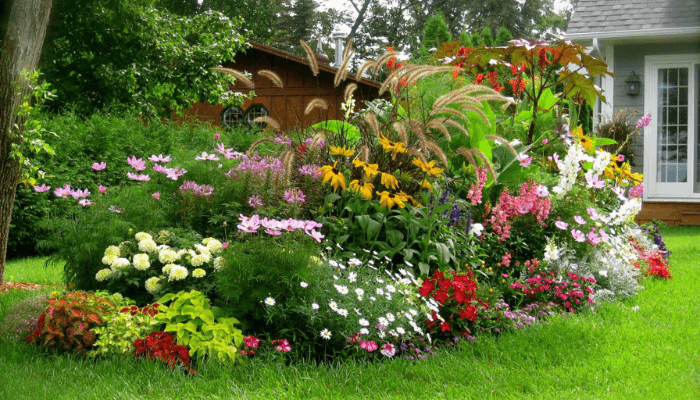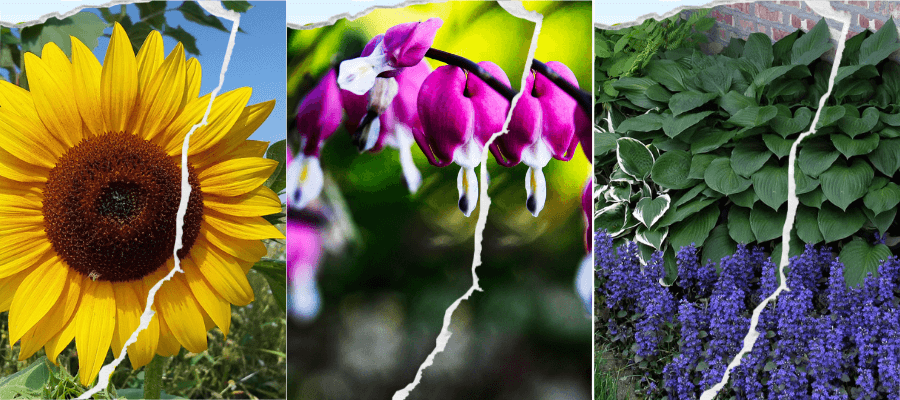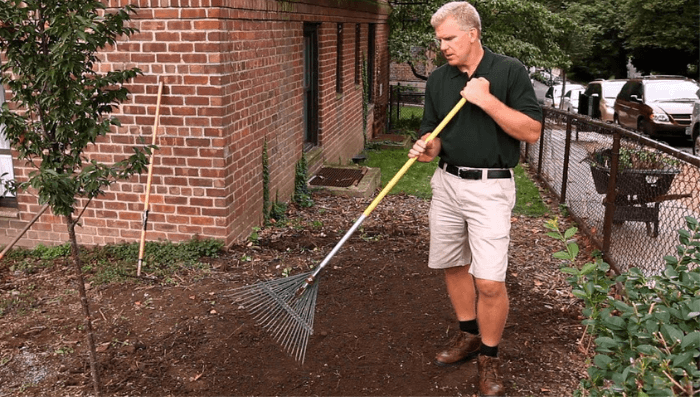Embarking on a gardening journey might seem daunting, but with the right knowledge and a clear plan, even beginners can cultivate a flourishing garden. Our simple 10 essential steps will help you create a beautiful garden that thrives your outdoor space.

1. Assess Your Garden Space and Conditions
Garden Space
- Measure your available space: Take accurate measurements of the area you plan to use for your garden. This will help you determine how many plants you can accommodate and guide you in creating an efficient layout.
- Obstacles and limitations: Identify any obstacles, such as large trees or existing structures, that may impact your garden design. Be aware of any limitations, like underground utilities or property boundaries, that could affect your plans.
Sun Exposure

- Full sun: Areas that receive at least six hours of direct sunlight per day are considered full sun. These spots are ideal for sun-loving plants like tomatoes, roses, and most annual flowers.
- Partial shade: Areas with three to six hours of sunlight per day are considered partial shade. Many perennials, such as hostas and ferns, thrive in these conditions.
- Full shade: Locations that receive less than three hours of direct sunlight per day are considered full shade. Some plants, like certain woodland wildflowers and ground covers, can grow in these low-light conditions.
Soil Conditions
- Texture: Soil texture affects water drainage and nutrient availability. Sandy soils drain quickly but can be nutrient-poor, while clay soils hold water and nutrients but can become compacted. Loamy soils, which are a mix of sand, silt, and clay, offer the best balance of drainage and fertility.
- pH: Soil pH influences nutrient availability for plants. Most plants prefer a slightly acidic to neutral soil pH, but some species, like blueberries or azaleas, require more acidic conditions.
- Drainage: Good drainage is essential for healthy root development. Test your soil’s drainage by digging a hole about 12 inches deep and filling it with water. If the water drains within a few hours, your soil has good drainage. If it takes longer, you may need to amend your soil or select plants that tolerate wet conditions.
2. Plan Your Garden Layout
- Sketch your garden: Create a rough sketch of your garden layout, including existing structures and landscape features. This will help you visualize the overall design and ensure proper plant placement.
- Design for function and beauty: Consider both practical and aesthetic aspects when designing your garden. Include paths for easy access, seating areas for relaxation, and focal points, like a water feature or sculpture, to add visual interest.
- Layering: When arranging plants, consider their mature height to create a sense of depth and dimension. Place taller plants, like trees and large shrubs, in the background, and shorter plants, like perennials and ground covers, in the foreground.
3. Choose the Right Plants
- Match plants to your garden conditions: Select plants that will thrive in your garden’s specific sun exposure, soil type, and climate. Research each plant’s requirements to ensure they are compatible with your garden.
- Consider maintenance needs: Choose plants with maintenance requirements that align with your lifestyle and gardening abilities. Some plants may require more frequent pruning, watering, or pest control than others.
- Include diversity: Incorporate a variety of plants in your garden, including annuals for seasonal color, perennials for long-lasting interest, and shrubs and trees for structure and shade. This will create a visually appealing landscape that supports a healthy ecosystem.
4. Prepare the Soil

- Remove weeds and debris: Clear the planting area of weeds, rocks , and other debris to create a clean slate for your new garden. Weeds can compete with your plants for nutrients, water, and sunlight, so it’s essential to eliminate them from the start.
- Amend the soil: Based on your soil test results, amend the soil with the appropriate organic matter to improve its texture, fertility, and drainage. Compost, aged manure, and leaf mold are excellent options for most gardens.
- Prepare planting beds: Till or dig the soil to a depth of 12 to 18 inches, incorporating the organic amendments as you work. This will help create a loose, well-aerated soil structure that promotes healthy root development.
5. Create a Planting Schedule
- Determine your region’s climate: Identify your region’s hardiness zone and average frost dates to guide your planting schedule. This information will help you determine the best time to plant each species in your garden.
- Plan for successive planting: To extend your garden’s bloom time and harvest, consider successive planting. Stagger the planting of annual flowers and vegetables throughout the season, ensuring a continuous supply of color and produce.
- Consult plant-specific guidelines: Research the specific planting requirements for each plant in your garden, including recommended planting times, spacing, and depth. This information will help you create a tailored planting schedule for your garden.
6. Plant with Care

- Follow recommended planting guidelines: Plant each species according to the guidelines provided by seed packets, plant labels, or reputable gardening resources. This includes proper spacing, planting depth, and support structures, such as trellises or stakes for climbing or vining plants.
- Water new plantings: Thoroughly water your newly planted garden, ensuring the soil is evenly moist but not waterlogged. This will help settle the soil around the roots and promote strong establishment.
- Mulch your garden: Apply a 2- to 3-inch layer of organic mulch, such as shredded bark or compost, around your plants. Mulch helps conserve moisture, suppress weeds, and maintain consistent soil temperature.
7. Establish a Routine for Watering and Feeding
- Water consistently: Provide your plants with consistent moisture, adjusting your watering frequency based on weather conditions and plant needs. Over- or underwatering can stress plants and make them more susceptible to pests and diseases.
- Feed your plants: Fertilize your plants according to their specific needs, using organic or synthetic fertilizers as appropriate. Be sure to follow label instructions for proper application rates and timing.
- Monitor soil moisture: Check your soil moisture regularly to ensure it remains evenly moist but not waterlogged. Adjust your watering routine as needed to maintain optimal conditions.
8. Keep Your Garden Well-Maintained
- Weed regularly: Stay vigilant in removing weeds from your garden, as they can compete with your plants for resources and harbor pests and diseases. Hand-pulling or using a hoe are effective methods for most gardens.
- Prune and deadhead: Regularly prune your plants to maintain their shape and encourage healthy growth. Remove spent flowers (deadheading) to promote continuous blooming and prevent self-seeding.
- Clean and maintain garden tools: Keep your garden tools clean, sharp, and in good working order to make garden maintenance more efficient and enjoyable.
9. Monitor for Pests and Diseases
- Inspect plants regularly: Check your plants for signs of pests and diseases, such as chewed leaves, discolored foliage, or unusual growths. Early detection and intervention are crucial for minimizing damage.
- Employ appropriate controls: Use organic or chemical controls as needed to manage pests and diseases, following label instructions carefully. Consider implementing integrated pest
- management (IPM) strategies, which combine cultural, biological, and chemical methods to maintain pest populations at acceptable levels.
- Encourage beneficial insects: Attract beneficial insects, like ladybugs and lacewings, to your garden by planting a variety of flowering plants and providing shelter. These insects can help control pest populations naturally.
- Practice good garden hygiene: Remove diseased plant material from your garden promptly and dispose of it properly to prevent the spread of pathogens. Keep your garden clean and well-maintained to discourage pests from taking up residence.
10. Enjoy Your Garden and Learn from Experience
- Observe and adapt: Spend time in your garden observing how your plants grow, interact, and respond to changes in their environment. Use this knowledge to make improvements and adjustments over time, ensuring your garden continues to thrive and evolve.
- Document your garden journey: Keep a garden journal to track your successes, challenges, and observations. This record can be a valuable resource for planning and refining your garden in the future.
- Share your garden with others: Invite friends and family to enjoy your garden, and consider participating in local garden tours or events. Sharing your garden can be a rewarding way to connect with others and celebrate your gardening accomplishments.
By following these ten essential steps, you’ll be well on your way to creating a thriving garden that brings joy and beauty to your outdoor space. With patience, persistence, and a willingness to learn, even novice gardeners can cultivate a flourishing garden that reflects their unique vision and style.


